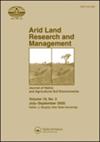Evaluating the influence of COVID-19 pandemic lockdown on Jordan Badia rangelands
IF 1.6
4区 农林科学
Q3 ENVIRONMENTAL SCIENCES
引用次数: 6
Abstract
Abstract To explore the effect of COVID-19 pandemic lockdown on vegetation cover changes in Northern, Middle, and Eastern Jordan Badia rangelands, Landsat-8 (Operational Land Imager [OLI]) images were downloaded and processed to attain surface reflectance data for March and July 2018–2020. Normalized difference vegetation index (NDVI) was then derived from OLI-images, where the total area covered with water, bare soil, scattered vegetation, dense grasses and shrubs, and dense forests were estimated. Across the study period, 2019 had the highest rainfall (195 mm) and temperature (21.7 °C), while the lowest rainfall was recorded in 2018 (154 mm). The Northern Badia showed a consistently larger area of dense vegetation on average (407.4 km2) compared to the Eastern (149.3km2), and Middle (55.2 km2) Badia. The total area covered with scattered vegetation in 2020 was higher than in 2019 and 2018 across the years and studied area, except in Middle Badia. Vegetation cover classes were inconsistent for Middle Badia in March, scattered vegetation was higher in 2019 compared to 2020. However, the total area covered with vegetation in July was lower than in March across the years and studied area. The curfew allowed the regeneration of shrubs and grasses in the study area, which helped in restoring the rangeland vegetation. COVID-19 lockdown served as a conservation grazing technique and provided a real case of restoring the degraded rangeland cover through managed grazing.评估新冠肺炎大流行封锁对约旦巴迪亚牧场的影响
为探讨新冠肺炎疫情对约旦巴迪亚牧场北部、中部和东部植被覆盖变化的影响,下载Landsat-8 (Operational Land Imager [OLI])卫星图像并进行处理,获取2018-2020年3月和7月的地表反射率数据。然后,利用oli影像得到归一化植被指数(NDVI),估算水体覆盖面积、裸土覆盖面积、植被分散覆盖面积、茂密草丛和灌木覆盖面积以及茂密森林覆盖面积。在整个研究期间,2019年的降雨量最高(195毫米),气温最高(21.7°C),而2018年的降雨量最低(154毫米)。巴迪亚北部平均植被密度为407.4 km2,高于东部(149.3km2)和中部(55.2 km2)。除中巴迪亚地区外,各年份和研究区域2020年散乱植被覆盖总面积均高于2019年和2018年。中巴迪亚3月植被覆盖等级不一致,2019年分散植被高于2020年。但各年份和研究区7月植被覆盖总面积均低于3月。宵禁使研究区域的灌木和草得以再生,这有助于恢复牧场植被。COVID-19封锁作为一种保护性放牧技术,提供了通过管理放牧恢复退化牧场覆盖的真实案例。
本文章由计算机程序翻译,如有差异,请以英文原文为准。
求助全文
约1分钟内获得全文
求助全文
来源期刊

Arid Land Research and Management
环境科学-环境科学
CiteScore
3.80
自引率
7.10%
发文量
23
审稿时长
9 months
期刊介绍:
Arid Land Research and Management, a cooperating journal of the International Union of Soil Sciences , is a common outlet and a valuable source of information for fundamental and applied research on soils affected by aridity. This journal covers land ecology, including flora and fauna, as well as soil chemistry, biology, physics, and other edaphic aspects. The journal emphasizes recovery of degraded lands and practical, appropriate uses of soils. Reports of biotechnological applications to land use and recovery are included. Full papers and short notes, as well as review articles and book and meeting reviews are published.
 求助内容:
求助内容: 应助结果提醒方式:
应助结果提醒方式:


